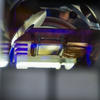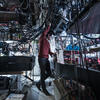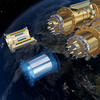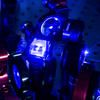You are here
Solace of quantum

Pascale Senellart is passionate about quantum physics. This research professor at the C2N1 has been scrutinising the infinitely small for over 20 years. Her areas of focus are photons (small elementary particles of light) and quantum boxes that can generate them “on demand”. These flat, lentil-shaped semiconductor nanostructures are made up of a cluster of approximately 10,000 atoms, and were discovered by chance forty years ago by researchers developing new materials for manufacturing lasers.
The scientific community did not find a concrete use for them in this field at first, but an experiment conducted in 1994 by the physicist Jean-Yves Marzin2 would change everything. “In that founding article, the scientists measured for the first time the emission of light by only one of these nano-objects, and showed that the energy levels of electrons are quantified inside it,” explains Senellart. “We had proof that the quantum box behaves like a single atom.” In short, an artificial atom of sorts.
Generating photons one by one
This work would be essential for the research conducted by Senellart, who began studying quantum boxes in 2002. While the atom is the only system in nature that can emit light by generating photons one by one, quantum boxes proved much easier to manipulate in the laboratory than individual atoms. “Still, the chances of capturing the photon were slim, for it was emitted in all directions in space,” she points out. Yet in 1946, the physicist Edward Purcell had shown that “the emission of light by an atom is a property that depends on both the atom and its electromagnetic environment”.
By placing the artificial atom in an optical cavity, it ended up trapped between two mirrors, forming a soundbox for light. The atom is thus coupled with the electric field in a vacuum confined inside the cavity, allowing the scientists to force it to emit its photon in a precise direction.

An obstacle nevertheless remained: how exactly to position a single quantum box or artificial atom within a cavity? For many years numerous scientists tried to force quantum boxes to form in a precise location. “This technique worked, but the emitted photons were of poor quality. The approach I proposed in 2005 was different, namely to let the quantum box form wherever it wanted to, and to detect it with nanometric precision by having it interact with a laser. We then built the cylinder-shaped optical cavity around it.”
Encoding quantum qubits
Two years later, this “somewhat far-fetched” idea became a reality, a genuine advance in the field of quantum optics: “This enabled us to generate photons on demand, and starting in 2013, we were able to capture most of them (nearly 80%)!” The physicist was awarded the 2014 CNRS Silver Medal for her work.
Many scientists working on quantum computing and communications based on light now contact her: “Researchers who use the photon to encode information were especially interested by our results.”
In fact, these light particles are excellent for encoding quantum bits (or qubits), the basic unit of quantum computers. In a computer equipped with classical bits, information is expressed as a series of 0s and 1s. The quantum computer uses qubits that are simultaneously 0s and 1s, in a state that is said to be “superposed”.
Entangling light particles
“The photons we generated at the time were not yet of sufficient quality” for this application though. Creating light-based quantum computers requires working with indistinguishable photons. The quantum box must therefore generate photon trains that are perfectly identical at all points, an essential condition for these light particles to entangle (in order for their quantum states to remain linked regardless of the distance separating them).
Entangling these photons largely increases computing power. “Imagine a labyrinth in which the classical computer can only explore one direction at a time, whereas with quantum superposition, multiple paths can be tested simultaneously. Adding entanglement to this picture allows multiple quantum particles to jointly explore all paths simultaneously, thereby finding the way out much more quickly."

However, generating identical photons remains difficult. “The smallest electric field interacting with an artificial atom will affect it, leading to the emission of different photons.” Between 2013 and 2016, the researcher and her team stepped up their efforts to develop a system in which the artificial atom interacts as little as possible with its environment. They notably added an electrical control to evacuate the disruptive electrons located near the atom. And stroke it lucky!
“In 2016 we reached 99.5% indistinguishability.” The result was so unbelievable that the researcher remained speechless: “It was too good to be true!” Senellart and her team had just developed photons suitable for quantum computing.
A radio telescope showed her the way
But how did the researcher develop this passion for quantum physics? While she was good at school as a child, science was not an obvious choice. Born in 1972 in the suburbs of Paris, she grew up near Orléans (central northern France), where her mother was a schoolteacher and her father an IBM salesman.
The young Senellart and her parents regularly travelled to Quincy near Bourges, in central France, where her four grandparents lived. “On the way we always drove past the Nançay Radio Observatory, home to one of the world’s first large radio telescopes.” With its two mirrors (respectively 35 and 40 meters in height), the structure sparked her curiosity. When it came time to choose where she would complete her Year 10 internship, she did not hesitate – it would be Nançay
“It was an extraordinary week. I began my internship with a technician, but I asked so many questions that they ended up putting me with the researchers.” She returned there during every school holiday. “I felt good with all those people who took the time to explain their scientific studies for me.”
After completing her A Levels, she enrolled for preparatory classes for the French Grandes Écoles. That brought her to the capital, where she joined the renowned institution Louis-le-Grand. Notions relating to quantum physics already intrigued her. “I knew that it was a different science, somewhat mysterious.”
A door opened…
Everything changed during the oral component of the entrance examination for the Lyon-based École nationale supérieure (ENS) in southeast France. In an exercise presented by her professors, a flow of light passed through two slits simultaneously, and then formed interference fringes in the background. “You had to imagine decreasing the flow until there was just a single particle of light, a photon, passing through the slits. Then they had me do an extraordinary thought exercise that connects with the foundations of quantum mechanics: if I tried to determine where this solitary photon was moving, I lost the interference figure.” The examiners had just opened a door that the future researcher would never close. Senellart knew then that she would study quantum physics.
In the end she did not join the ENS, but the equally prestigious Polytechnique engineering school in 1993, where she finally discovered quantum mechanics. She was also fascinated by semiconductor materials thanks to her interactions with the physicists Claude Weisbuch and Claudine Hermann, who was “the first female professor in the history of École polytechnique”.
Senellart began a PhD on these intriguing research topics. She defended her thesis in 2001, and spent a few months in an industrial laboratory at Schlumberger (currently SLB), where she developed semiconductor lasers to detect the composition of natural gas. She then served as a temporary teaching and research assistant at Université Paris 7, while continuing her research in another industrial laboratory at Thales.
A year later she applied at the CNRS, and joined the former photonics and nanostructures laboratory. “It was a dream come true.”
Quandela sees the light of day
Her experience in industry changed how she analysed things, testify the researchers who knew her when she was completing her thesis. It also sparked a genuine entrepreneurial spirit, so when her young colleague Niccolo Somaschi proposed founding a start-up to bring to market the single-photon source they had developed in the laboratory, she decided to embark on the adventure.
They launched Quandela in 2017 with Valérian Giesz, who was a doctoral student at C2N at the time. “We have very complementary backgrounds and get on really well,” explains Senellart, who joined the French Academy of Sciences in 2022, and the French Academy of Technologies in March 2025.
Like the entangled photons she studies, the physicist is exploring multiple avenues at the same time. Moving back and forth between the start-up and C2N was facilitated by the creation of the QDLight joint research laboratory in 2024. “The studies conducted at Quandela drive basic research at C2N, and vice versa. It’s a positive and permanent feedback loop,” she enthuses.
New avenues for basic research
Since 2020, the start-up has taken on a new dimension, as Senellart and her colleagues entered the race to create a quantum computer: “Our first model equipped with six qubits was developed in late 2022, and we are continually working to increase its capacities.”
Will the quantum supercomputer of the future originate from Quandela’s laboratories? One thing is certain: this booming field of research holds many surprises in store. “By working on the generation and manipulation of photons, we keep opening new pathways for basic research that will perhaps lead to other applications.” ♦
Further reading
Cryptography faces the threat of quantum technology
- 1. Centre for Nanoscience and Nanotechnology (CNRS / Université Paris-Saclay). The C2N was created from the merger of the LPN photonics and nanostructures laboratory and the IEF institute of fundamental electronics.
- 2. Jean-Yves Marzin passed away in 2023. He was the director of the then Institute for Engineering and Systems Sciences (INSIS), now CNRS Enginering. Among other fields, he devoted his research to the optical properties of micro- and nanostructures.




















